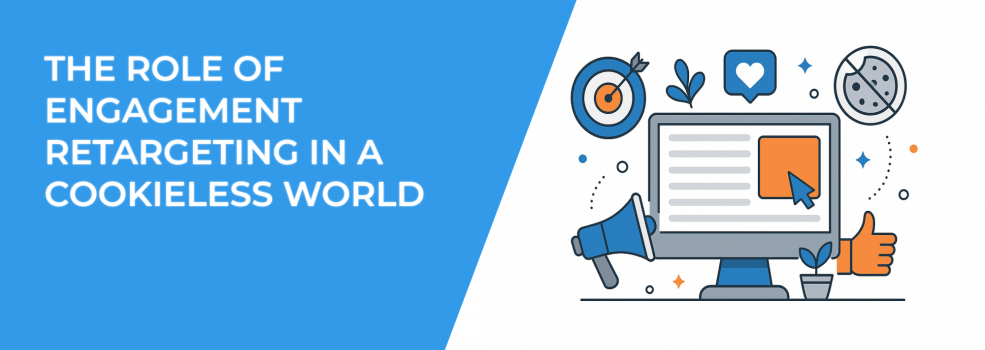Digital advertising is in the middle of a big shift. Cookies — once the backbone of online targeting — are disappearing. Privacy regulations, ad blockers, and browser updates are forcing marketers to rethink how they connect with potential customers.
In this cookieless world, one strategy is becoming a cornerstone of digital marketing: engagement retargeting. Instead of depending on third-party cookies, it focuses on first-party data — the actual actions people take when interacting with your content.
Did someone watch half of your video ad? Did they click a carousel image? Did they open your lead form but never submit? These behaviors create powerful signals that can fuel a new kind of retargeting strategy.
Why Traditional Retargeting Is Losing Power
For years, cookie-based retargeting was the bread and butter of digital campaigns. A visitor came to your site, a cookie tracked them, and you could show them tailored ads across the web. But those days are nearly gone.
-
Safari and Firefox already block third-party cookies by default.
-
Google Chrome — with over 60% market share — is phasing them out in 2025.
-
Privacy-first policies are making it harder to track users across multiple sites.
What’s the result? Smaller retargeting audiences, rising costs, and less effective campaigns. Marketers who keep relying only on cookies will fall behind.
This is where engagement retargeting proves its value.
What Engagement Retargeting Really Means
Engagement retargeting uses the interactions people already have with your ads, social content, or website to build warm, privacy-compliant audiences.
Instead of “following” users across the internet, you focus on signals like:
-
Video views (25%, 50%, 75%, 95%)
-
Ad clicks and link clicks
-
Social post interactions (likes, shares, comments, saves)
-
Time spent on key pages
-
Form opens or partial completions
These aren’t just numbers — they’re intent signals. When someone chooses to engage, they’re telling you they’re interested. And in a world where generic retargeting is shrinking, these signals are gold.
If you want to sharpen your understanding of Facebook targeting basics before diving deeper, check out Facebook Ad Targeting 101: How to Reach the Right Audience.
Practical Engagement Retargeting Scenarios
Want to see how this works in practice? Here are a few examples advertisers use every day:
-
Video Retargeting: If 2,000 people watch 75% of your product video, retarget them with a demo ad. They’ve already shown strong interest.
-
Lead Magnet Retargeting: People clicked to check your ebook but didn’t download? Run a reminder ad highlighting the key insights they’ll miss.
-
Website Behavior Retargeting: Visitors who spend two minutes on your pricing page but don’t convert can be retargeted with a limited-time discount.
-
Engagement Funnel: Run a three-step sequence — awareness ad → retarget engaged viewers → final conversion ad.
This approach filters out the noise and ensures your ad spend goes toward people who are already paying attention.
Engagement retargeting works best when paired with a broader funnel approach. For a complete breakdown of structuring ads from awareness to conversion, see Facebook Ads Funnel Strategy: From Audience Identification to Conversion.
Why Engagement Retargeting Is Perfect for a Cookieless World
Marketers are calling engagement retargeting one of the most future-proof retargeting strategies.
Here’s why:
-
Built on first-party data — You own the interactions, no third-party dependency.
-
Privacy-friendly — People actively choose to engage, aligning with global privacy regulations.
-
Higher ROI — Budgets focus on users with proven interest, not cold audiences.
-
Scalable across platforms — Works on Facebook, Instagram, LinkedIn, TikTok, and even email journeys.
The cookieless future doesn’t eliminate retargeting. It reshapes it into something more meaningful — and more effective.
How to Start with Engagement Retargeting
If you’re ready to future-proof your advertising strategy, here’s a checklist to follow:
-
Segment audiences inside Ads Manager — Create lists of video viewers, post engagers, and form interactions.
-
Test engagement thresholds — Compare retargeting results at 25% vs. 75% video views to find your sweet spot.
-
Layer campaigns — Don’t stop with one retargeting ad. Build a journey that nurtures users closer to conversion.
-
Blend with identity-based targeting — Upload email lists, CRM contacts, or past customers to expand reach.
-
Measure long-term ROI — Look beyond last-click conversions. Engagement audiences often convert later in the funnel.
The earlier you start refining engagement-based audiences, the stronger your campaigns will perform in 2025 and beyond.
Retargeting audiences become even more powerful when paired with other smart tactics. For example, learning How to Set Up Facebook Retargeting will give you step-by-step instructions to build custom audiences in Ads Manager.
Final Thoughts
The loss of cookies is not the end of retargeting. It’s the beginning of something more sustainable and customer-friendly. Engagement retargeting takes what matters most — the actions people willingly take — and turns them into signals for smarter, more efficient advertising.
The advertisers who win in the cookieless world will be those who stop chasing disappearing cookies and start building strategies around meaningful engagement.
So the question is — are you setting up engagement retargeting audiences now, or will you wait until it’s too late?

